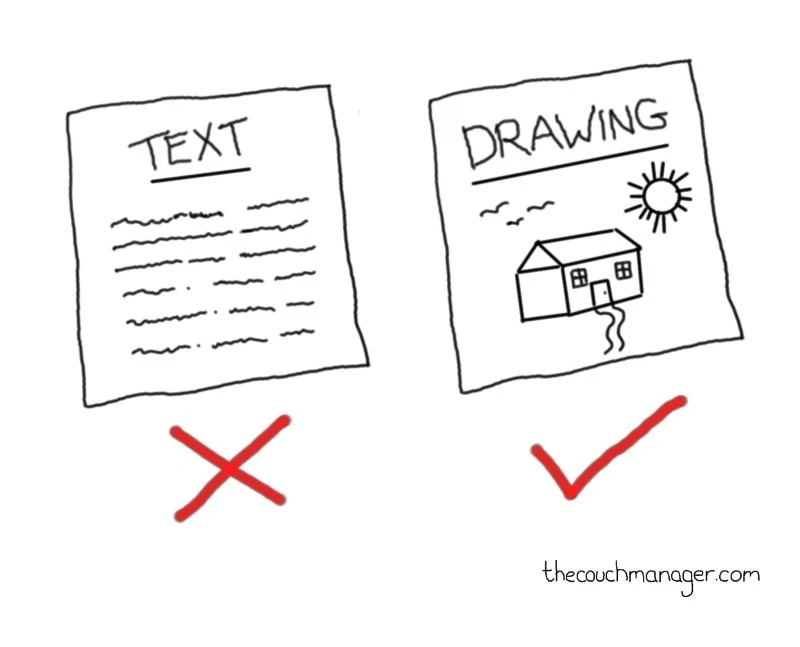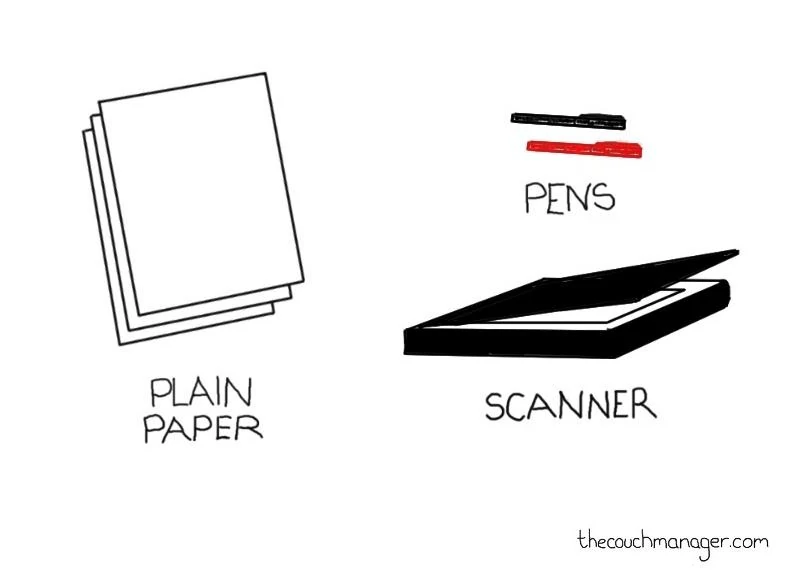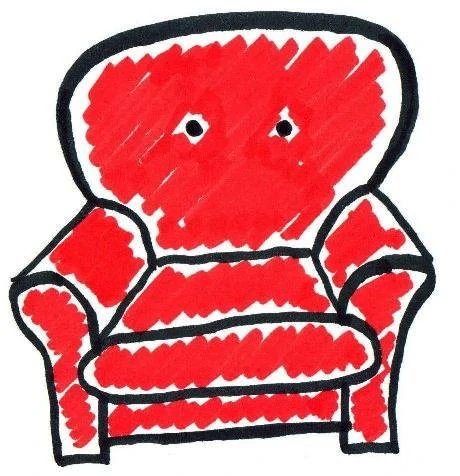Drawings and sketches are some of the most effective ways to explain anything to anyone (that’s why I use them frequently on my blog).
They help people understand a problem and see its solution in a much more efficient way than talking about it or writing it out.
I’m not referring to the usual PowerPoint diagrams or Excel charts (even though those are definitely helpful), but rather to plain old hand-drawn pictures.
I can guarantee that regardless of what industry you’re in, you can always use some form of drawing to help simplify an idea or get a point across much faster.
During my days as a management consultant, nearly every major problem I had to solve with my team was hashed out on a whiteboard at some point. On a typical project, we’d lock ourselves in a conference room for a day, roll up our sleeves, and the lead Partner would kick off our meeting by saying “Pens to the Board!”
As a couch manager who leads remote teams, the benefits of using hand-sketched drawings are even greater. You can portray an idea in a much more effective way that “sticks” with your virtual teams. For example, all the information I just wrote can be summarized in the following simple sketch:
 Of course, it takes a bit more time to create a drawing, but the return on investment is definitely higher.
Of course, it takes a bit more time to create a drawing, but the return on investment is definitely higher.
You Don’t Need to Know How to Draw
Some people cringe at the thought of having to draw anything – including myself.
I was terrible at drawing pictures during my undergraduate years. That was one of the reasons why I left pursuing a degree in Architecture to a less “drawing-intensive” Civil Engineering degree instead.
However, I learned two things over the last few years:
- You don’t have to be perfect at drawing to convey an idea. In fact, some people actually prefer to look at a semi-baked, imperfect drawing. I’m not sure why, but I guess it’s because people can relate more to it that way, so don’t get too obsessive about creating the perfect picture before sharing it.
- You can become phenomenal at drawing by reading one book. A couple of years ago, I came across THE book about creating drawings for solving problems and selling ideas. It’s called Unfolding the Napkin: The Hands-On Method for Solving Complex Problems with Simple Pictures (affiliate link) written by Dan Roam. Highly recommended. As a side note, the book was based on a previous book Dan Roam wrote called The Back of the Napkin: Solving Problems and Selling Ideas with Pictures. I only read the Unfolding the Napkin book and I was set, but you might want to read both if you’d like to become an expert.
In any case, even if you don’t have the time to read either book, here’s what you need to know to create any hand drawn picture.
4 Steps to create any hand-drawn sketch
Step 1: Gather the Stuff You’ll Need
Technically, you’ll only need the following three things:
For the scanner, I use my all-in-one Canon Pixma MX350 Wireless Printer (affiliate link), which produces excellent scans, but you really don’t need anything fancy. Any regular cheap scanner will do.
Step 2: Decide What You Want to Draw (using a little trick)
When I was creating a logo for The Couch Manager blog, I wanted to draw some form of couch, but had absolutely no idea how to do so. I tried looking at my couch at home, and attempted at hand-sketching it like an artist, but that ended up a disaster.
I then discovered a neat little trick that helped me decide what to draw.
I simply logged on to Google.com, clicked on the “Image” tab at the top, and then searched for the word “Couch.” This got me tons of images of couches to use as a reference.
However, the images were more of actual pictures than sketches (which makes them harder to imitate), so what I did was I added the word “Sketch” to the search (i.e. I searched for the phrase “Couch Sketch”), and I got over 2.4 million sketches to choose from.
That’s how I ended up getting an idea for sketching out my blog’s logo:
The words “Drawing,” “Cartoon” and “Hand drawn” also work if the word “Sketch” doesn’t give you great results.
The additional cool thing about using Google Image search is that it also helps you come up with ideas if you’re stuck.
Step 3: Draw It Out (using another little trick)
After you figure out what you want to draw, you can eye-ball the image and draw a similar sketch directly on plain paper (that’s what I usually do; again, the picture never has to be perfect to be effective).
However, if you’d like to avoid testing your artistic abilities, another trick you can use is just print out the picture from Google Image search, and then put it underneath the plain paper as you trace the lines on top.
You can also use the same trick if you’d like to write out free-hand text that’s horizontal. Just use regular lined paper underneath the plain paper and follow the faint lines across the page to align your text.
Step 4: Scan, Modify, and Share
After you’re done with your drawing, you’ll need some form of software to edit the sketches (like cropping, color adjusting, resizing etc.).
I use MS Office Picture Manager (free with Microsoft Office) to crop the pictures and then adjust the midtone settings so that the black and red colors pop out.
For more sophisticated picture adjustment, you can use GIMP (which is free software that is very similar to Adobe Photoshop).
I then just save the picture as a JPG file and then simply import it into a presentation, email it out to the team or upload it to my blog!
And that’s it! Let me know if you found this post helpful by commenting below.


Thanks! Definitely my idea of the day. Off to Google to find a few images.
Fantastic post. Drawing gets right down into the issue and yours are irresistible. I shall copy. Thank you
I was just wondering about this the other day. You must have been reading my mind! Thanks for sharing these tips, I plan to use them asap. 🙂
Thanks Carrie – by the way, speaking of pictures, I have Carl Richards’ new book, “The Behavior Gap,” (http://www.behaviorgap.com/) on my list of books to read this year. He’s got some cool sketches in it. Thought you might find it interesting as well given that it touches on your area of expertise!
Wow, I actually ordered “The Behavior Gap” book the other day. I haven’t gotten it in the mail yet, but once I do it’s going to the top of my book reading list. I guess great minds think alike 🙂 Thanks for the suggestion, now I know it will be a really good read.